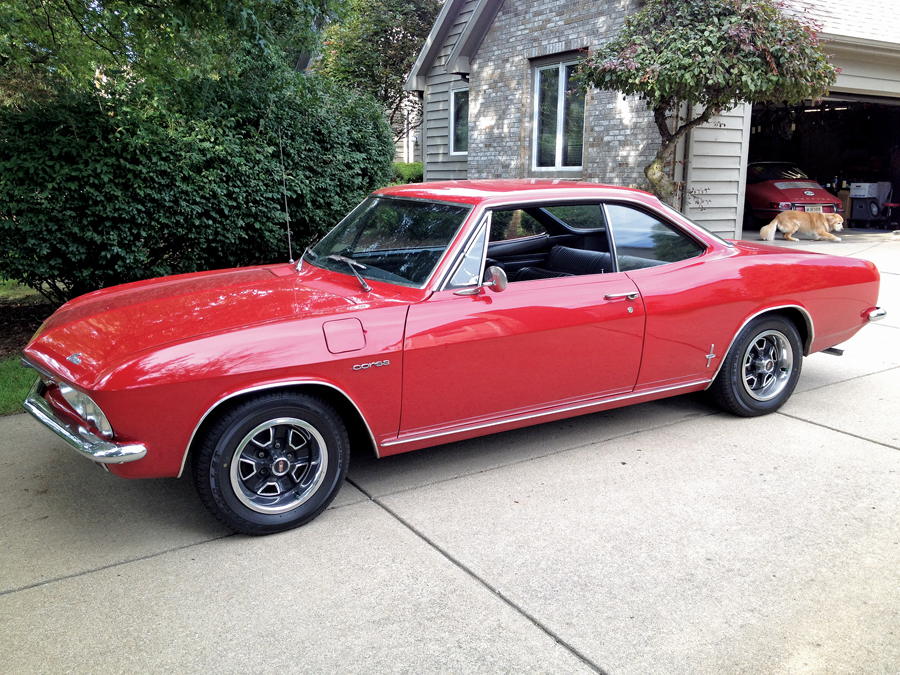In the fall of 1964, Chevrolet introduced the second-generation Corvair in direct competition with the Ford Mustang. While the Mustang seemed to take all the air out of the room for a small, sporty American car, independent thinkers in the know realized the two competing products couldn’t be more different.
The Mustang was great looking, to be sure. But underneath the shiny sheet metal were mundane Ford Falcon mechanicals. The perimeter frame, solid rear axle, economy-car brakes and off-the-shelf iron-block engines provided modest performance. Over the years, upgraded Mustangs with bigger engines would become quite formidable. But the underpinnings were strictly yesterday’s news.
A different approach
The 1965 Corvair took a different path. Its all-alloy, horizontally opposed, air-cooled, 6-cylinder engine was mounted in the rear, just like the recently launched Porsche 911. The new Corvair shared the 911’s double-jointed rear axles instead of the swing axles of the 356 and earlier Corvairs (1960–64). Some reviewers called it the “poor man’s Porsche” and indeed, as a college student, I passed the income test.
It was developed with unibody construction, like Porsches were from the start. 1965 Corvair engines were 2.7 liters — a size Porsche would adopt starting in 1973. Corvairs pioneered turbocharging, an approach also used by Porsche a decade later. The Corvair even used a horizontal cooling fan, as Porsche would deploy in the mighty 917 race cars.
But what hooked me was an ad in our local newspaper: The redesigned Corvair was flat beautiful. The new body, devoid of excess filigree or chrome, was part of a movement bringing cleaner, purer designs all about form and function rather than fins. This distinctive approach was carried into the interior as well, with flat floors, roomy cabins and simple, effective dashboards. Had the Bauhaus movement found a new home in southeastern Michigan?
Good performance, nice price
The top-of-the-line Corsa came with either the 4-carb 140-hp engine or a turbocharged version with a peakier 180 hp. Like most turbos back then, there was plenty of lag, so many buyers opted for the quicker responses of the 140.
Most Corsas and Monzas are 4-speeds, and the shifting, while notchy compared with the 911’s butter-smooth 901 gearbox, is nonetheless quite positive in action. The popular 140-hp engine was torquey, both off the line and at midrange, as was common for American cars of the day. The Corsa dash had six instruments, and the rear body cove was painted in Argent Silver, as were other top-line Chevy models.
A best-in-the-world Corsa today is about $20k, a very nice one, $15k, and at $10k, you’ll find plenty of decent examples. Just as with any unibody vehicle, look for rust. Many of these got lots of hard use, so try to find one without huge mileage. Unless you are very handy, or find a car that is an especially good deal, a Corsa already made right is your best bet. If you can’t afford a good one, you probably can’t afford a bad one, either.
Monzas were the middle trim level and many are equipped with the 140-hp engine, 4-speed combo just like a Corsa. I suggest you try to hold out for a Corsa, although it will take longer to find a good one at a fair price. The automatic transmission in a Corvair is a 2-speed and tends to hurt resale value, although a good one can still be fun to drive.
Parts are widely available and usually at friendly prices. There are talk boards (www.corvairforum.com) and Clark’s Corvairs (www.corvair.com) is a specialist supplier which offers a tremendous depth of parts, both original and repros.
Preach and practice
I purchased the car in the photos off an Internet talk list for $5,000. It’s a real 140-hp 4-speed Corsa, but it needed quite bit of mechanical work to be driven regularly. I did a complete brake overhaul and rebuilt the carbs and distributor, as well as addressed a host of other mechanical issues. This is a Southern car, so the only rust is in the bottom of the front trunk, which is easy to repair. It has a wonderful original interior, testifying to good care throughout its life. After all repairs I have about $9,000 in it, and although it’s far from perfect, it’s great fun to drive.
Corvairs have incredibly light unassisted steering, and the ride is supple as long as you don’t go wild on wide wheels, fat tires and stiff shocks. These wheels are 14-inch GM Rally Wheels from the period — purchased off a local Craigslist ad complete for all of $140 — and a step up from the 13-inch original wheels. The sound from the stock 140-hp twin exhaust, still available through Clark’s, is mellow and quite distinctive.
Alongside the Corvair, I have been working on our 1964 356SC sunroof this summer, and have been driving both quite a bit on all kinds of errands. People glance at the Sky Blue Porsche and wonder if it’s some sort of Karmann Ghia. But the Corvair draws a crowd. People who rarely look at whatever old car I am driving will walk across the parking lot to talk about the Corvair.
The entire experience of buying and driving the Corvair reminds me of messing around in old Porsches a quarter century ago, before the rest of the world caught on. It remains as easy to find an old Corvair as it was buying old 356s (and early 911s) way back when. Prices are reasonable, and there is no stampede of buyers Googling every offering from around the world.
So take your time and find a good one. But do remember that you will have to be an independent thinker to make it all work. ♦
Jim Schrager is the author of Buying, Driving, and Enjoying the Porsche 356, and Buying, Driving, and Enjoying the 1965–1973 Porsche 911 and 912.
